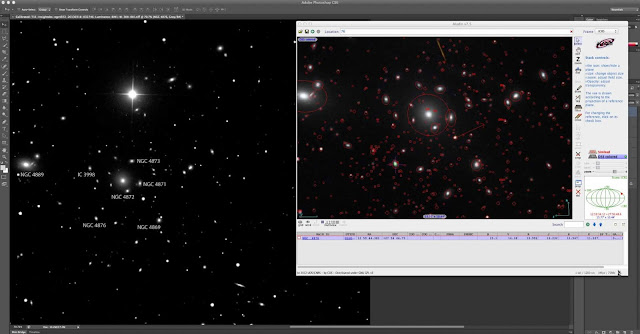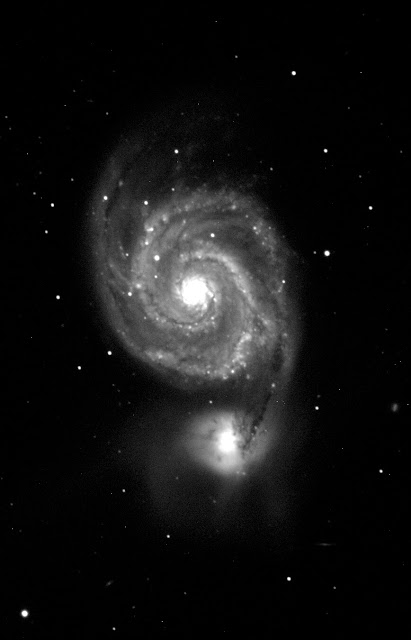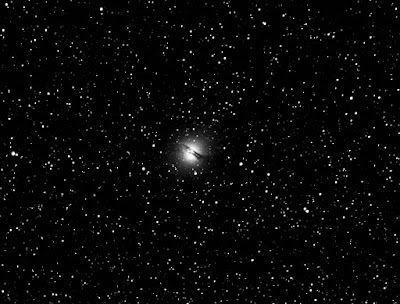After experimenting with iTelescope.net's remote robotic telescopes for astronomy education, imaging galaxies, and galaxy clusters, I figured it was now a good time to target another type of deep-sky object. First thing this morning around 3:00am, MDT, Telescope T-21 (Planewave 17" f/4.5 CDK) was available for imaging at New Mexico Skies. The moon's phase was near full in the western part of the sky and Messier 13 (M13), the Great Globular Cluster in Hercules was becoming high in the eastern part of the sky. This was my first attempt at imaging a deep-sky object when the moon was so bright using these telescopes.
After making a 5-minute exposure with only a luminance filter, the result is what you see to the left. I used the FITS Liberator and Adobe Photoshop CS6 for post-processing. I converted the FITS-processed grayscale image to RGB in Photoshop and added a blueish hue to the image for effect.
I find it absolutely amazing that when there is nearly a full moon in the night sky, observers are still able to take images of deep-sky objects with no interference from the moonlight. As I referred to the "All-Sky Camera" at New Mexico Skies to check the sky conditions before imaging, I could barely make out only a few of the brightest stars accompanied by an overexposed view of the moon. Also, because of today's technology with advanced CCD Cameras and precision mounts that track the sky so accurately, it only takes about 5 minutes to get an image like the one above.
Messier 13 (M13), also designated NGC 6205 and sometimes called the Great Globular Cluster in Hercules or the Hercules Globular Cluster, is a globular cluster of about 300,000 stars in the constellation of Hercules.M13 is about 145 light-years in diameter, and it is composed of several hundred thousand stars, the brightest of which is the variable star V11 with an apparent magnitude of 11.95. M13 is 25,100 light-years away from Earth. 13 was discovered by Edmond Halley in 1714, and cataloged by Charles Messier on June 1, 1764. The Arecibo message of 1974, containing encoded information about the human race, DNA, atomic numbers, and Earth's position, was beamed there for being picked up by a potential extraterrestrial civilization. It will reach the cluster in 25,000 years.
Read More
 |
| M13 - Globular Cluster in Hercules - 300-Second Exposure |
After making a 5-minute exposure with only a luminance filter, the result is what you see to the left. I used the FITS Liberator and Adobe Photoshop CS6 for post-processing. I converted the FITS-processed grayscale image to RGB in Photoshop and added a blueish hue to the image for effect.
I find it absolutely amazing that when there is nearly a full moon in the night sky, observers are still able to take images of deep-sky objects with no interference from the moonlight. As I referred to the "All-Sky Camera" at New Mexico Skies to check the sky conditions before imaging, I could barely make out only a few of the brightest stars accompanied by an overexposed view of the moon. Also, because of today's technology with advanced CCD Cameras and precision mounts that track the sky so accurately, it only takes about 5 minutes to get an image like the one above.
Messier 13 (M13), also designated NGC 6205 and sometimes called the Great Globular Cluster in Hercules or the Hercules Globular Cluster, is a globular cluster of about 300,000 stars in the constellation of Hercules.M13 is about 145 light-years in diameter, and it is composed of several hundred thousand stars, the brightest of which is the variable star V11 with an apparent magnitude of 11.95. M13 is 25,100 light-years away from Earth. 13 was discovered by Edmond Halley in 1714, and cataloged by Charles Messier on June 1, 1764. The Arecibo message of 1974, containing encoded information about the human race, DNA, atomic numbers, and Earth's position, was beamed there for being picked up by a potential extraterrestrial civilization. It will reach the cluster in 25,000 years.













